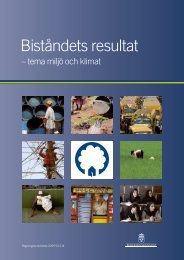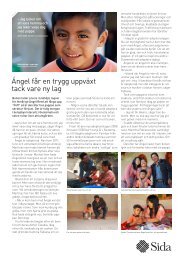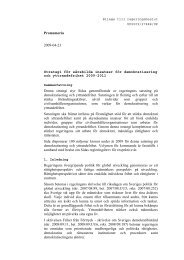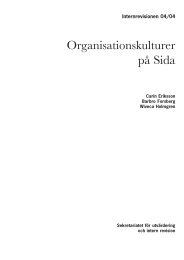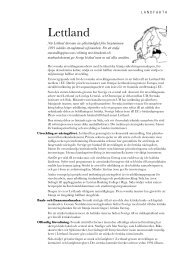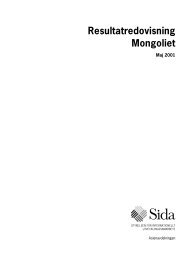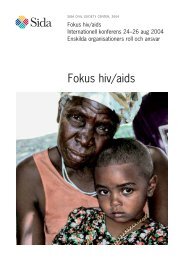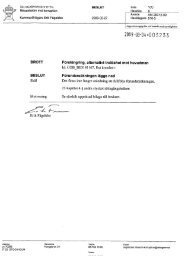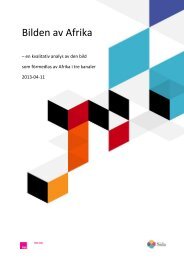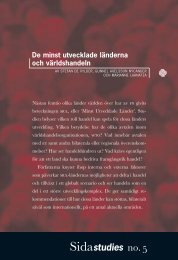Mid-Term Review of the AGIR Programme - Sida
Mid-Term Review of the AGIR Programme - Sida
Mid-Term Review of the AGIR Programme - Sida
Create successful ePaper yourself
Turn your PDF publications into a flip-book with our unique Google optimized e-Paper software.
E X E C U T I V E S U M M A R Y<br />
impact. However, since it is unrealistic to expect all CSO partners to manage<br />
complex information systems, <strong>the</strong> <strong>AGIR</strong> programme could focus on setting<br />
methodologies and standards for information collection and analysis, which in<br />
an initial phase could be centrally managed by <strong>AGIR</strong> and eventually replicated<br />
in organisations at a smaller scale. This could have <strong>the</strong> instrumental value<br />
<strong>of</strong> assessing <strong>the</strong> impact <strong>of</strong> <strong>AGIR</strong> as a programme, while at <strong>the</strong> same time<br />
could contribute to streng<strong>the</strong>ning <strong>AGIR</strong> partner monitoring and evaluation<br />
systems to become effective instruments for results-based management.<br />
The adoption <strong>of</strong> results-based management is a key outcome <strong>of</strong> <strong>the</strong> <strong>AGIR</strong><br />
programme and part <strong>of</strong> its capacity development strategy; thus <strong>the</strong> programme<br />
has to ei<strong>the</strong>r restrict <strong>the</strong> principle <strong>of</strong> respecting partners’ existing monitoring<br />
systems and put in place a more uniform system for <strong>the</strong> use by partner CSOs,<br />
or drastically ramp up its capacity-streng<strong>the</strong>ning processes concerned with<br />
M&E activities.<br />
The <strong>AGIR</strong> programme should fine-tune <strong>the</strong> reporting on impact in <strong>the</strong> <strong>the</strong>matic<br />
areas, clarifying <strong>the</strong> results chain and revisiting <strong>the</strong> <strong>the</strong>ory <strong>of</strong> change that<br />
implicitly proposed to constantly check <strong>the</strong> extent to which those specific<br />
achievements represent steps towards <strong>the</strong> intended change proposed by <strong>AGIR</strong>.<br />
This should inform incremental changes in <strong>the</strong> scope and nature <strong>of</strong> interventions<br />
that <strong>the</strong> partners make in <strong>the</strong> implementation <strong>of</strong> <strong>the</strong>ir strategic plans<br />
aligning <strong>the</strong>m with <strong>the</strong> programme objectives. On <strong>the</strong> basis <strong>of</strong> <strong>the</strong> above, it is<br />
recommended that <strong>AGIR</strong> reviews <strong>the</strong> result matrix in light <strong>of</strong> new partner recruitment<br />
and to systematise <strong>the</strong> annual planning matrix as to clearly demonstrate<br />
how partner activities feed in to outcomes (and <strong>the</strong>n adjust <strong>the</strong> result<br />
matrix accordingly).<br />
Many <strong>of</strong> <strong>the</strong> <strong>AGIR</strong> partners’ initiatives contribute to improving access to<br />
rights, to eliciting more accountability and to promoting good governance.<br />
Some <strong>of</strong> <strong>the</strong>se results, however, are only immediate and will not necessarily<br />
lay <strong>the</strong> foundation for <strong>the</strong> perpetual reproduction <strong>of</strong> a strong civil society able<br />
to hold <strong>the</strong> government responsible. Consequently, <strong>AGIR</strong> needs to continually<br />
identify those elements that are likely to produce impact and to reproduce<br />
practices that will guarantee <strong>the</strong> sustainability <strong>of</strong> <strong>the</strong> results achieved.<br />
<strong>AGIR</strong> CSOs<br />
The <strong>AGIR</strong> intermediaries should establish a strategic plan for <strong>the</strong> graduation<br />
<strong>of</strong> CSOs who have streng<strong>the</strong>ned <strong>the</strong>ir capacity to a point deemed sustainable<br />
by <strong>the</strong> programme (meaning survival without programme support). As discussed<br />
in <strong>the</strong> review, at some point <strong>the</strong>re has to be a limit to <strong>the</strong> number <strong>of</strong><br />
<strong>AGIR</strong> CSO partners that can be supported by <strong>the</strong> intermediaries, a limit based<br />
on <strong>the</strong> capacity <strong>of</strong> <strong>the</strong> intermediary to directly and fully support each CSO as<br />
envisioned within <strong>the</strong> programme planning. If <strong>the</strong> programme is to grow (ei<strong>the</strong>r<br />
with more donors and/or additional intermediaries) how and when CSOs<br />
move from nursery to core status and finally, to graduate out <strong>of</strong> <strong>the</strong> pro-<br />
11




